INDIAN ARMED FORCES CHIEFS ON OUR RELENTLESS AND FOCUSED PUBLISHING EFFORTS

The insightful articles, inspiring narrations and analytical perspectives presented by the Editorial Team, establish an alluring connect with the reader. My compliments and best wishes to SP Guide Publications.

"Over the past 60 years, the growth of SP Guide Publications has mirrored the rising stature of Indian Navy. Its well-researched and informative magazines on Defence and Aerospace sector have served to shape an educated opinion of our military personnel, policy makers and the public alike. I wish SP's Publication team continued success, fair winds and following seas in all future endeavour!"

Since, its inception in 1964, SP Guide Publications has consistently demonstrated commitment to high-quality journalism in the aerospace and defence sectors, earning a well-deserved reputation as Asia's largest media house in this domain. I wish SP Guide Publications continued success in its pursuit of excellence.
ETA is Excellent Time for Aviation
The President of India set the ball rolling for India Aviation 2016 by talking about the unmatched opportunities in aviation here, unlike any other country

The fifth edition of India Aviation, held from March 16-20 at Begumpet Airport in Hyderabad, has had many takeaways. For the first time India Aviation was inaugurated by the President of India, Pranab Mukherjee, in a way endorsing that India has arrived in many sectors and aviation was distinctly on the horizon. Though there were no bigticket deal announcements at India Aviation, the positive sentiments that prevail are enough to give wings to aviation here to get into the top three slots of aviation markets, only after China and the United States. Importantly, the Ministry of Civil Aviation, under the leadership of P. Ashok Gajapathi Raju has taken on its role as a facilitator more seriously than any known regime. At Hyderabad this was clearly evident as both the Minister and the Civil Aviation Secretary, R.N. Choubey unambiguously mentioned that the government would help create an ecosystem for aviation not just to survive but also thrive.
- INDIA ON THE THRESHOLD OF MAJOR LEAP IN AVIATION
- GOVERNMENT IN THE PROCESS OF CREATING ECOSYSTEM FOR AVIATION TO THRIVE
The President set the ball rolling by talking about the unmatched opportunities in aviation here, unlike any other country. “India is one of the fastest growing economies of the world and is expected to be amongst the top three manufacturing destinations by 2020. The stable and consistent policies of the government; favourable demographic dividends; growing infrastructure; sustained availability of low-cost skilled work-force and strong technical and engineering capabilities has made India a favourable destination for foreign direct investment (FDI).
Least Penetrated Air Market
It is heartening to note that Indian civil aviation market is growing at a rapid pace and now ranks ninth in the world. It is estimated that by 2020, India would be the third largest civil aviation market. With a network of domestic and 85 international airlines connecting 40 countries, Indian airports handled passenger traffic of 190 million persons in 2015. Yet India is one of the least penetrated air markets in the world with 0.04 trips per capita per annum as compared to 0.3 of China and more than 2 in the United States. Air travel has ceased to be a luxury these days. The middle-income population of India has grown by 60 per cent over the last five years and has reached about 270 million in 2016.
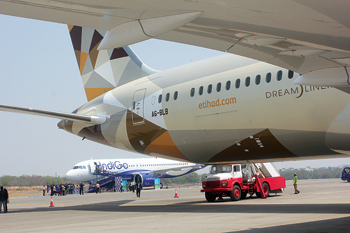
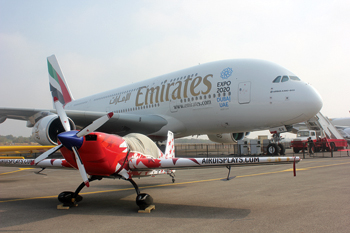
NCAP in April
The Civil Aviation Minister said that the much-awaited civil aviation policy would be announced by April 2017. “The work on the new aviation policy is in an advanced stage. We have put out the draft policy in the public domain. We are now seeking the guidance of senior ministers. The new policy will be out by April this year. There are 22 items in the draft policy and some of them have implications on the growth of the sector. Our idea is to give a boost to the entire ecosystem so that air connectivity in the country improves substantially.” The proposed policy will address this issue along with the restrictive 5/20 rule for operating international flights. “Once cleared by the Union Cabinet, the policy will be unambiguous on this issue,” the Minister said.
He said that 25 countries participated in the event while seven states partnered. As many as 210 companies were represented at the show while 29 aircraft were on display. Two partner countries were the United States and Canada.
The President of FICCI, Harshvardhan Neotia, said: “Enormous growth in domestic passenger traffic, substantial strengthening through government initiatives, decrease in global crude oil prices and airlines showing profits indicates a significantly positive transformation for the Indian civil aviation market. The close partnership between the government and the industry in ongoing and future projects will further improve regional connectivity. I am certain that the sector will take complete advantage of the positive momentum and help sustain the growth.”
Boeing on a Roll
Boeing, which had a large presence at the airshow, said it was happy the way things were unfolding in India. Boeing has a backlog of 97 aircraft to be delivered in India, 75 to Jet Airways; 19 to Air India and three to SpiceJet. These commitments will be fulfilled soon as Boeing sees an upward swing in market sentiments and airlines returning to profitability in India.
IN JANUARY 2013 FUEL ACCOUNTED FOR 49 PER CENT OF THE OPERATIONAL COST AND IN FEBRUARY 2016, IT HAD COME DOWN TO 23 PER CENT
The Boeing Senior Vice President, Asia Pacific & India Sales, Dr Dinesh Keskar said the company was in sync with the government which wanted the airframers to create an ecosystem while selling an aircraft in India. The ecosystem consisted of setting up or helping setting up of an MRO facility; training and simulation support; and facilitating leasing options for buyers. Boeing has done all of these – helped set up the MRO unit for Air India in Nagpur; has training and simulation facility and connects buyers to lessors.Reiterating Boeing’s market update for India, he said, the projected demand for new planes is 1,740 valued at $240 billion. Single aisle aircraft in which Boeing had a strong hold would comprise 84 per cent (1,460); 15 per cent (260) wide-body jets; and one per cent (20) regional jets.
Fuel Now 23 Per Cent of Operating Cost
Keskar said that fuel prices had decreased 53 per cent from the October 2013 peak and that Indian carriers pay over 50 per cent more for fuel than the US carriers. The reduction in fuel cost has been driving impact of landing and navigation fees on direct operating cost. In January 2013 fuel accounted for 49 per cent of the operational cost and in February 2016, it had come down to 23 per cent which was good for the airline industry in India.
Airbus Soaring Higher
After IndiGo’s order of 250 Airbus A320neo in late 2015, the European aerospace behemoth is so hooked on to India that it is betting really big. Airbus is set to deliver one aircraft every week to India over the next ten years, reflecting the market potential and growth in the country.
PAWAN HANS IS PLANNING TO DEVELOP FOUR HELI HUBS IN THE COUNTRY AT DELHI, MUMBAI, GUWAHATI AND ANOTHER ONE IN ANDHRA PRADESH
With an estimated 10 per cent annual traffic growth rate over the next decade, India will require over 1,600 new passenger and freighter aircraft in the next ten years to help meet the growing demand, said the President of Airbus in India Dr Srinivasan Dwarakanath and Vice President (Marketing) Joost Van der Heijden. The demand includes 1,200 single aisle and 400 wide-body aircraft with a total market value of $224 billion. India is well on its way to become the third largest aviation market by 2034.
Presenting a bullish outlook for Indian civil aviation sector, the two senior executives of Airbus said their company was a proud partner in Prime Minister Narendra Modi’s ‘Make in India’ initiative to create a robust ecosystem for improving air connectivity in the country. “Every Airbus aircraft is partly made in India,” declared Dwarakanath while outlining his company’s initiatives in fostering cooperation and helping Indian aerospace and aviation sector grow substantially over the last few decades.
“India’s preference for Airbus aircraft was further consolidated in 2015 with 250 new firm orders, lifting the market share of orders and the in-service fleet to over 70 per cent. At present, about 56 per cent of India’s in-service fleet are Airbus aircraft operated by most leading Indian carriers. This includes India’s first A320neo, the first to be delivered in the Asian region,” Dwarakanath said.
IndiGo A320neo Makes Debut
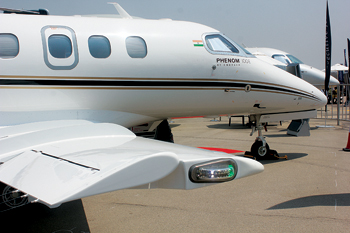
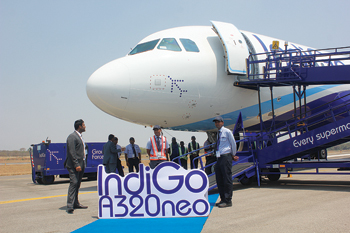
IndiGo’s first A320neo made an appearance on the opening day. IndiGo has ordered 180 aircraft in 2011 and 250 in 2015. Airbus said Air India would be its future A320neo customer from 2017. Air India and Alafco have signed a lease agreement for operating lease of 14 A320neo aircraft. Air India already operates 66 A320 family aircraft including 22 A319, 24 A320 and 20 A321. Air India was the first airline in India to operate A320s and it was 27 years ago.
Embraer Enjoying Good Buys
Embraer Executive Jets, which announced sale of Phenom 100E to an undisclosed customer in India but to be managed by Titan Aviation group, is excited about the Indian market. The Vice President (Sales) Middle East and Asia Pacific, Claudio Camelier said that the company was satisified with the performance in India, but would strive to do better, though the market conditions were not favourable worldwide.
Camelier said that the sales could be similar to that of last year, but did not disclose what the number was. The global momentum would pick up on recovery of the US economy. In India, he added, the sentiments were favourable and hoped that the push for regional connectivity would help business aviation too. The company has a 33 per cent market share across all business jets.
Bombardier’s Solid Base in India
The Canadian transportation company, Bombardier, has an Engineering Service Office in Bengaluru which supports Bombardier Aerospace’s in-production and in-development aircraft programmes by providing assistance to both the company and the more than 400 engineers at its partners’ offices in the areas of complex engineering structure design, advanced stress analysis and project management services.
Bombardier predicts that over the next 20 years, a total of 1,330 business jet deliveries are destined for India, and that the Asia-Pacific region (including China) will take delivery of approximately 4,000 aircraft in the 20- to 149-seat commercial aircraft category. In recent years, Bombardier has developed a solid base of customers in the region, and many of its industry-leading products, including Learjet, Challenger and Global business jets, CRJ700 regional jets and Q400 NextGen turboprops, are already in service in India. Bombardier Commercial Aircraft and Tech Mahindra recently signed an agreement under which the latter will develop the Aircraft Ground Support System (AGSS) for Bombardier’s Aircraft Health Management System (AHMS) for the C Series family of aircraft.
Honeywell Expands Services
Honeywell Aerospace has been selected by Jet Airways to provide maintenance services for Auxiliary Power Units (APU) on board its fleet of 10 Boeing 777 airplanes. The five-year agreement will help Jet Airways better predict and manage maintenance cycles, allowing the India-based airline to reduced unscheduled downtime and improve reliability of its fleets.
“We recognise that unplanned maintenance is an essential yet sometimes costly procedure,” said Arijit Ghosh, President, Honeywell Aerospace India.
“Our APU maintenance programme coupled with Predictive Trend Monitoring Diagnostic service provides Jet Airways the tools to simplify budget planning and mitigate unexpected costs that may arise due to unscheduled removals, as well as speed up turnaround for its B777 fleet.”
Falcon 8X in India by Year-End
Dassault Aviation which is the market leader here for large cabin, long range aircraft, with 22 aircraft currently in service and several more on order, showcased its most popular 4,000 nm/7,410 km range Falcon 2000LXS widebody twinjet. “We expect the country’s accelerating economic growth to translate into rising Falcon sales going forward,” said Dassault Aviation Chairman/CEO Eric Trappier. “No other business jet line is more suited to local requirements, whether it be in terms of cabin design, flying performance, fuel economy or versatility, than Falcon.”
Dassault’s popular Falcon 2000 twinjet – now approaching the 600th production mark - accounts for the largest portion of the present Indian fleet. Sales are currently being driven by the Falcon 2000LXS, the newest edition in the 2000 line, which offers a short-field capability comparable to smaller midsize and super midsize business jet models but with a range and comfort level far better than these aircraft.
Vadim Feldzer of the communications department of Falcon said that majority of new Indian Falcon orders, however, are for longer range models like the Falcon 7X and the new ultra long range Falcon 8X that can fly non-stop from anywhere in India to destinations such as London City Airport that are typically off limits to big business jets. The 6,450 nm/11,945 km Falcon 8X, which will feature the quietest and most comfortable cabin in business aviation, is due to be delivered to its first Indian operator by the end of 2016.
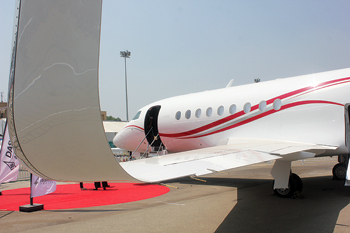
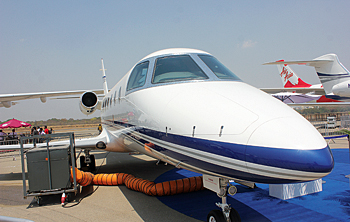
Gulfstream Hoping for Market to Open Up
Savannah based Gulfstream had brought two aircraft — G150 and G650. Gulfstream’s service centre in Dallas was authorised by India’s Directorate General of Civil Aviation (DGCA) to perform maintenance on all DGCA-registered Gulfstream aircraft. The US-based business jet manufacturer is hopeful that the government policies would give the right push to general aviation in general and business aviation in particular.
Textron to Make Bell Copters in India
Textron Inc is likely to build its single largest selling helicopter – Bell 407 – in partnership with Indian firms for the ecosystem and that includes avionics, rotors, gearbox etc. The company has undertaken a market feasibility study. Textron has a development centre in Bengaluru, employing 500 aeronautical engineers. The company has a tie-up with Dynamatic Ltd to manufacture the Bell 407 cabins in Bengaluru, to cater to the export markets, especially the US and Canada. The Bengaluru unit can manufacture four 407 cabins a month. The company is looking at marketing reconnaissance and surveillance helicopters to the armed forces.
Pawan Hans Vertical Growth
The state-owned Pawan Hans Ltd, India’s largest helicopter operating company, has drawn up massive expansion plans to increase the number of helicopters from the present 43 to 100 by 2025 and also to develop four heli hubs across the country. The company is planning to go for an initial public offering (IPO) in 2017. “We need at least Rs. 5,000 crore to implement our acquisition plan. We are going for IPO and procurement on lease basis,” said the Managing Director of Pawan Hans Dr B.P. Sharma.
The company is planning to develop four heli hubs in the country at Delhi, Mumbai, Guwahati and another one in Andhra Pradesh. The heli hubs offer complete solutions which include terminals for passengers, MRO facilities and skill development centres for training of pilots and engineers.
It is also focusing on heli-tourism and development of helipads across the country. The signing of two memoranda of understanding (MoUs) with the Hindustan Aeronautics Limited (HAL) and Indian Railway Catering and Tourism Corporation (IRCTC) are pointers in this direction. The MoU with HAL will facilitate establishment of complete MRO facility at Rohini heliport, Delhi, the first such facility in the country to be operationalised in June this year.
Pawan Hans is also talking with Airbus Helicopters to set up an MRO unit in Juhu airport in Mumbai. India currently has about 300 civilian helicopters. Pawan Hans has flown over 5,00,000 hours with more than 19 lakh landings.
Telangana’s Skill Development Centre
The Telangana Government signed an MoU with Aero Campus Aquitaine of Bordeaux Metropole of France to set up India’s first training centre for skill development in aerospace industry. The academy will come up at Begumpet Airport in Hyderabad. Aero Campus Aquitaine has presence in Turkey, Malaysia and many other countries and they are world leaders in their area.
All in all, the India Aviation event has gained a place on the international events map, but it has a long way to go before it becomes a ‘must attend’ for global players. Right now, the show seems stretched by five days.





